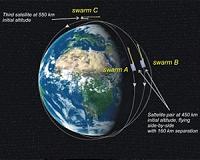 |
Greenbelt MD (SPX) Sep 16, 2010 In August 1960, NASA launched its first communications satellite, Echo 1. Fifty years later, NASA has achieved another first by placing the ARTEMIS-P1 spacecraft into a unique orbit behind the moon, but not actually orbiting the moon itself. This type of orbit, called an Earth-Moon libration orbit, relies on a precise balancing of the Sun, Earth, and Moon gravity so that a spacecraft can orbit about a virtual location rather than about a planet or moon. The diagrams below show the full ARTEMIS-P1 orbit as it flies in proximity to the moon. ARTEMIS-P1 is the first spacecraft to navigate to and perform stationkeeping operations around the Earth-Moon L1 and L2 Lagrangian points. There are five Lagrangian points associated with the Earth-Moon system. The two points nearest the moon are of great interest for lunar exploration. These points are called L1 (located between the Earth and Moon) and L2 (located on the far side of the Moon from Earth), each about 61,300 km (38,100 miles) above the lunar surface. It takes about 14 to 15 days to complete one revolution about either the L1 or L2 point. These distinctive kidney-shaped orbits are dynamically unstable and require weekly monitoring from ground personnel. Orbit corrections to maintain stability are regularly performed using onboard thrusters. After the ARTEMIS-P1 spacecraft has completed its first four revolutions in the L2 orbit, the ARTEMIS-P2 spacecraft will enter the L1 orbit. The two sister spacecraft will take magnetospheric observations from opposite sides of the moon for three months, then ARTEMIS-P1 will move to the L1 side where they will both remain in orbit for an additional three months. Flying the two spacecraft on opposite sides, then the same side, of the moon provides for collection of new science data in the Sun-Earth-Moon environment. ARTEMIS will use simultaneous measurements of particles and electric and magnetic fields from two locations to provide the first three-dimensional perspective of how energetic particle acceleration occurs near the Moon's orbit, in the distant magnetosphere, and in the solar wind. ARTEMIS will also collect unprecedented observations of the space environment behind the dark side of the Moon - the greatest known vacuum in the solar system - by the solar wind. In late March 2011, both spacecraft will be maneuvered into elliptical lunar orbits where they will continue to observe magnetospheric dynamics, solar wind and the space environment over the course of several years. ARTEMIS stands for "Acceleration, Reconnection, Turbulence and Electrodynamics of the Moon's Interaction with the Sun". The ARTEMIS mission uses two of the five in-orbit spacecraft from another NASA Heliophysics constellation of satellites (THEMIS) that were launched in 2007 and successfully completed their mission earlier this year. The ARTEMIS mission allowed NASA to repurpose two in-orbit spacecraft to extend their useful science mission, saving tens of millions of taxpayer dollars instead of building and launching new spacecraft. Other benefits of this first ever libration orbit mission include the investigation of lunar regions to provide a staging location for both assembly of telescopes or human exploration of planets and asteroids or even to serve as a communication relay location for a future lunar outpost. The navigation and control of the spacecraft will also provide NASA engineers with important information on propellant usage, requirements on ground station resources, and the sensitivity of controlling these unique orbits. The ARTEMIS mission implementation and operation represents a joint effort between NASA Goddard Space Flight Center in Greenbelt, Md., the Jet Propulsion Laboratory in Calif., and the University of California, Berkeley, Space Sciences Laboratory.
Share This Article With Planet Earth
Related Links Goddard Space Flight Center Space Technology News - Applications and Research
 CEA-Leti Completes Scalar Magnetometer Prototype For ESA
CEA-Leti Completes Scalar Magnetometer Prototype For ESAGrenoble, France (SPX) Sep 15, 2010 CEA-Leti has said that a prototype of the new-generation scalar magnetometer, which it designed and developed in partnership with CNES, has passed the qualification step en route to being deployed in the SWARM space mission. SWARM, a project of the European Space Agency, is scheduled for launch in 2011 or 2012. The mission's objective is to provide the best-ever survey of the Earth's magne ... read more |
|
| The content herein, unless otherwise known to be public domain, are Copyright 1995-2010 - SpaceDaily. AFP and UPI Wire Stories are copyright Agence France-Presse and United Press International. ESA Portal Reports are copyright European Space Agency. All NASA sourced material is public domain. Additional copyrights may apply in whole or part to other bona fide parties. Advertising does not imply endorsement,agreement or approval of any opinions, statements or information provided by SpaceDaily on any Web page published or hosted by SpaceDaily. Privacy Statement |